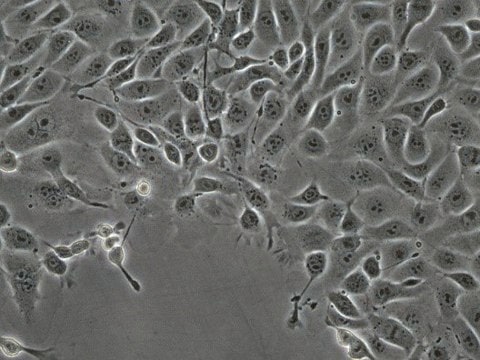SCC180
OECM-1 Human Oral Squamous Carcinoma Cell Line
Human
Sinônimo(s):
OECM1, OEC-M1
About This Item
Produtos recomendados
Nome do produto
OECM-1 Human Oral Squamous Carcinoma Cell Line, OECM-1 human oral squamous carcinoma cell line is suitable for studies of cancer cell signaling, epithelial-mesenchymal transition (EMT), metastasis, invasion, and cancer cell stemness.
fonte biológica
human
técnica(s)
cell culture | mammalian: suitable
Descrição geral
Source:
The OECM-1 human oral cavity squamous cell carcinoma cell line was derived from surgical resection of a primary tumor of a Taiwanese male patient [4].
Descrição de linhagem celular
Aplicação
Cancer
Qualidade
• Cells are tested negative for HPV-16, HPV-18, Hepatitis A, B, C, and HIV-1 & 2 viruses by PCR.
• Cells are verified to be of human origin and negative for inter-species contamination from rat, mouse, chinese hamster, Golden Syrian hamster, and non-human primate (NHP) as assessed by a Contamination CLEAR panel by Charles River Animal Diagnostic Services.
• Cells are negative for mycoplasma contamination.
• Each lot of cells is genotyped by STR analysis to verify the unique identity of the cell line.
Armazenamento e estabilidade
Exoneração de responsabilidade
Código de classe de armazenamento
12 - Non Combustible Liquids
Classe de risco de água (WGK)
WGK 1
Ponto de fulgor (°F)
does not flash
Ponto de fulgor (°C)
does not flash
Certificados de análise (COA)
Busque Certificados de análise (COA) digitando o Número do Lote do produto. Os números de lote e remessa podem ser encontrados no rótulo de um produto após a palavra “Lot” ou “Batch”.
Já possui este produto?
Encontre a documentação dos produtos que você adquiriu recentemente na biblioteca de documentos.
Active Filters
Nossa equipe de cientistas tem experiência em todas as áreas de pesquisa, incluindo Life Sciences, ciência de materiais, síntese química, cromatografia, química analítica e muitas outras.
Entre em contato com a assistência técnica








